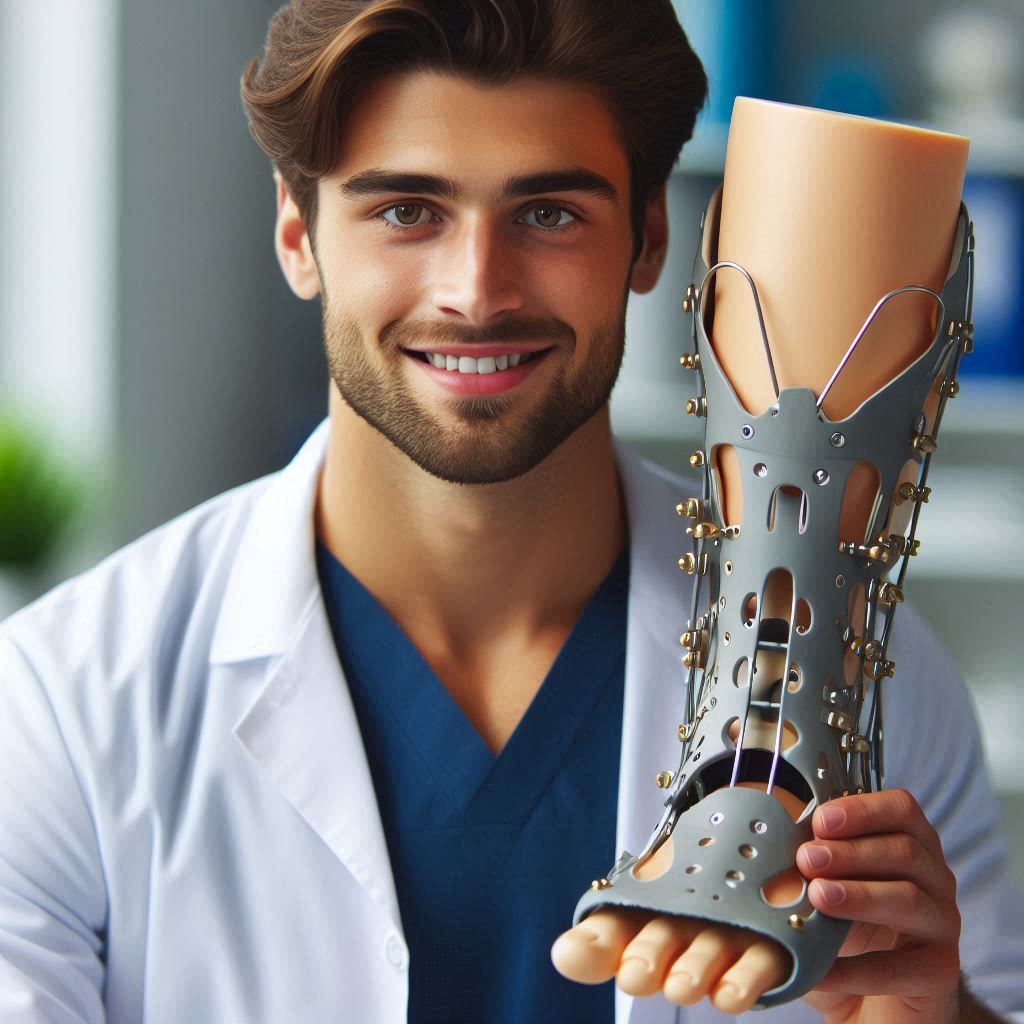Introduction
An orthotist/prosthetist is a healthcare professional who designs, fabricates, and fits orthopedic braces and artificial limbs.
Orthotists focus on supportive devices, while prosthetists specialize in artificial limbs.
These professionals play a crucial role in enhancing the quality of life for individuals with physical impairments.
They help patients regain mobility and independence, significantly impacting their daily lives.
Orthotists/prosthetists assess patients’ needs and create custom devices. They use advanced technology and materials to ensure optimal fit and function.
These devices can range from simple foot orthotics to complex prosthetic limbs.
Orthotists/prosthetists work closely with patients, ensuring their devices meet their unique requirements and preferences.
They also provide ongoing support and adjustments as needed.
In this blog post, we will explore the roles and responsibilities of orthotists/prosthetists. We will discuss the education and training required for this profession.
Additionally, we will cover the skills necessary for success in this field.
We will also highlight the various work environments where orthotists/prosthetists can be found.
Finally, we will examine the future outlook and opportunities for growth in this rewarding career.
By understanding the vital contributions of orthotists/prosthetists, we can appreciate their essential role in healthcare.
Education and Training Requirements
Orthotists/prosthetists play a crucial role in helping individuals regain mobility and independence through the design and fabrication of orthotic and prosthetic devices.
To become a qualified professional in this field, there are specific education and training requirements that need to be fulfilled.
Bachelor‘s Degree in Orthotics and Prosthetics
One of the primary requirements to become an orthotist/prosthetist is to obtain a bachelor’s degree in orthotics and prosthetics from an accredited institution.
The coursework in this program typically includes anatomy, physiology, biomechanics, materials science, and other relevant subjects.
Students learn about the principles of orthotic and prosthetic design, fabrication techniques, and patient assessment skills during their undergraduate studies.
Accredited Prosthetic and Orthotic Program
After obtaining a bachelor’s degree, aspiring orthotists/prosthetists need to complete a clinical residency program in prosthetics and orthotics.
These programs are accredited by the National Commission on Orthotic and Prosthetic Education (NCOPE) and provide hands-on training under the supervision of experienced practitioners.
Transform Your Career Today
Unlock a personalized career strategy that drives real results. Get tailored advice and a roadmap designed just for you.
Start NowDuring the residency, students gain practical experience in assessing patients, designing custom devices, and fitting and adjusting orthotic and prosthetic devices.
Clinical Experience and Certification Exams
After completing the residency program, individuals must obtain clinical experience by working under the supervision of a licensed orthotist/prosthetist for a specified period of time.
Once the clinical experience requirement is met, candidates are eligible to sit for certification exams administered by the American Board for Certification in Orthotics, Prosthetics & Pedorthics (ABC).
Passing these exams demonstrates competency in the field and qualifies individuals to practice as certified orthotists and prosthetists.
In fact, the education and training requirements for orthotists/prosthetists are rigorous and comprehensive to ensure that they are well-equipped to provide quality care to patients in need of orthotic and prosthetic devices.
By completing a bachelor’s degree, accredited residency program, gaining clinical experience, and passing certification exams, individuals can pursue a rewarding career in this specialized healthcare field.
Read: Networking Tips for Aspiring Public Health Administrators
Job Responsibilities
Orthotists and prosthetists play an essential role in helping individuals regain mobility and improve their quality of life.
Here are some of the key responsibilities they perform:
Designing and Fitting Orthopedic Braces
Orthotists specialize in designing and fitting orthopedic braces.
These braces are custom-made devices that provide support, stability, and alignment to various parts of the body.
Orthotists work closely with patients to assess their needs and create braces that fit comfortably and effectively.
Creating and Fitting Prosthetic Limbs
Prosthetists are responsible for creating and fitting prosthetic limbs for individuals who have lost a limb due to injury, illness, or congenital conditions.
They work with patients to design prosthetic limbs that are tailored to their unique anatomy and meet their functional goals.
Prosthetists ensure that the prosthetic limb fits properly, is comfortable to wear, and allows the individual to move naturally.
Working Closely with Patients
Orthotists and prosthetists work closely with patients throughout the process of designing, fitting, and adjusting orthopedic braces and prosthetic limbs.
They collaborate with healthcare providers, physical therapists, and other specialists to ensure that the devices meet the individual’s specific needs and provide the necessary support and functionality.
Orthotists and prosthetists also educate patients on how to properly use and care for their devices to optimize their effectiveness and longevity.
Overall, orthotists and prosthetists are dedicated to enhancing the lives of their patients by providing them with custom-made orthopedic braces and prosthetic limbs that improve mobility, function, and overall well-being.
Read: Orthotist/Prosthetist Community Outreach and Advocacy
Transform Your Career Today
Unlock a personalized career strategy that drives real results. Get tailored advice and a roadmap designed just for you.
Start NowWork Settings
Orthotists and prosthetists play a crucial role in the healthcare industry by providing customized orthotic and prosthetic devices to patients with physical disabilities.
These professionals work in a variety of settings, each offering unique challenges and opportunities to make a positive impact on patients’ lives.
Orthotists and prosthetists work in various settings, including:
Hospitals and Rehabilitation Centers
One common work setting for orthotists and prosthetists is hospitals and rehabilitation centers.
In these environments, they collaborate with a multidisciplinary team of healthcare professionals to assess patients’ needs and provide them with appropriate orthotic and prosthetic devices.
Orthotists and prosthetists in hospitals and rehabilitation centers work closely with physical therapists, occupational therapists, and physicians to create treatment plans tailored to each patient’s unique goals and abilities.
Prosthetic and Orthotic Clinics
Another work setting for orthotists and prosthetists is prosthetic and orthotic clinics.
These clinics specialize in providing orthotic and prosthetic services to patients with various physical disabilities, such as limb loss or spinal cord injuries.
Orthotists and prosthetists in these settings work directly with patients to assess their functional needs, design custom orthotic and prosthetic devices, and provide ongoing care and support to ensure optimal outcomes.
Prosthetic and orthotic clinics are often equipped with advanced technology and resources to help orthotists and prosthetists deliver high-quality care to their patients.
Private Practice or as Part of a Healthcare Team
Some orthotists and prosthetists choose to work in private practice or as part of a healthcare team in a clinical setting.
In private practice, orthotists and prosthetists have the flexibility to set their own schedule and specialize in specific areas of orthotics and prosthetics.
They may work with a diverse range of patients, from athletes seeking performance-enhancing orthotic devices to individuals with congenital disabilities requiring long-term orthotic care.
Orthotists and prosthetists in private practice often collaborate with other healthcare professionals, such as podiatrists, neurologists, and orthopedic surgeons, to provide comprehensive care to their patients.
In review, orthotists and prosthetists work in various settings, each offering unique opportunities to make a difference in patients’ lives.
Whether they work in hospitals, prosthetic and orthotic clinics, or private practice, these professionals play a vital role in helping individuals with physical disabilities achieve greater independence and improve their quality of life.
Read: Public Health Administration: Key Challenges and Solutions

Find Out More: Top Skills Required for a Successful Surgical Technologist
Salary and Job Outlook
Median Salary for Orthotists/Prosthetists
Orthotists and prosthetists earn a median annual salary of around $68,410, according to the U.S. Bureau of Labor Statistics.
However, this figure can vary based on several factors.
Transform Your Career Today
Unlock a personalized career strategy that drives real results. Get tailored advice and a roadmap designed just for you.
Start NowExperience, education, certification, and location are some of the key factors that can influence an orthotist/prosthetist’s salary.
Those with advanced degrees or specialized certifications tend to earn higher salaries.
Additionally, orthotists/prosthetists working in metropolitan areas or areas with a higher cost of living may earn a higher salary compared to those working in rural areas.
Projected Job Growth in the Field
The job outlook for orthotists/prosthetists is promising, with a projected growth rate of 17% from 2019 to 2029.
This growth rate is much faster than the average for all occupations.
The increasing prevalence of chronic conditions such as diabetes and cardiovascular disease, as well as an aging population, is expected to drive the demand for orthotic and prosthetic devices.
Advancements in technology and materials used in orthotics and prosthetics are also contributing to the growth of the field, creating a need for skilled professionals to design and fit these devices.
Factors Influencing Salary and Job Opportunities
Several factors can influence the salary and job opportunities for orthotists/prosthetists.
- Education and Certification: Advanced degrees and specialized certifications can lead to higher salaries and better job prospects.
- Experience: As with any profession, experience plays a significant role in determining salary levels and job opportunities.
- Location: Working in high-demand areas or metropolitan areas can result in higher salaries and more job opportunities.
- Industry Setting: Orthotists/prosthetists employed by hospitals or rehabilitation centers might have different salary levels compared to those working in private practices or research institutions.
- Specialization: Specializing in a specific area of orthotics or prosthetics, such as pediatrics or sports medicine, can also impact salary and job opportunities.
Read: How Technology is Transforming Orthotics and Prosthetics
Skills and qualities needed
When it comes to the role of an Orthotist/Prosthetist, there are certain skills and qualities that are essential for success in this profession.
Let’s take a closer look at what these skills and qualities are:
Attention to detail
Attention to detail is vital for orthotists and prosthetists. They must create devices tailored to individual needs.
Small errors can lead to discomfort or improper function. Precision ensures that devices fit well and provide maximum benefit.
Every measurement and adjustment must be exact. Orthotists and prosthetists often work with complex materials and technology.
Their ability to notice and correct minor issues is critical. Detail-oriented professionals can improve patient outcomes and satisfaction.
This skill also aids in maintaining high standards and adhering to regulations.
Strong interpersonal skills
Strong interpersonal skills are essential for success in this profession.
Orthotists and prosthetists frequently interact with patients, caregivers, and healthcare teams.
They must communicate effectively to understand patient needs and provide clear instructions. Empathy helps in building trust and easing patient anxieties.
Good interpersonal skills also facilitate collaboration with colleagues. They ensure smooth coordination during the design and fitting processes.
Transform Your Career Today
Unlock a personalized career strategy that drives real results. Get tailored advice and a roadmap designed just for you.
Start NowThese professionals often support patients through challenging times. Their ability to connect with others enhances patient care and teamwork.
Problem-solving abilities
Problem-solving abilities are indispensable for orthotists and prosthetists. They encounter diverse challenges, from fitting issues to mechanical failures.
Effective problem solvers can quickly devise solutions to complex problems. This ability ensures that patients receive timely and appropriate care.
Orthotists and prosthetists must adapt to changing patient conditions and needs. They must think creatively to design custom devices.
Their problem-solving skills contribute to continuous improvement and innovation.
This quality helps in addressing unique cases and improving patient mobility and comfort.
In a nutshell, attention to detail, strong interpersonal skills, and problem-solving abilities are vital for orthotists and prosthetists.
These qualities enable them to provide high-quality care and improve patient lives.
Conclusion
Orthotists and prosthetists play a vital role in healthcare. They design, fit, and fabricate orthopedic braces and prosthetic limbs.
These devices help patients regain mobility and independence. Orthotists focus on creating braces that support or correct musculoskeletal issues.
Prosthetists specialize in designing artificial limbs for those who have lost limbs due to injury or illness. Both professions require technical skills and empathy.
Orthotists and prosthetists work closely with patients to ensure the best possible fit and function of their devices.
They collaborate with doctors, physical therapists, and other healthcare professionals.
The work of orthotists and prosthetists significantly enhances patients’ quality of life.
Their expertise allows patients to perform daily activities and achieve their goals.
The satisfaction of helping patients overcome physical limitations is immensely rewarding.
Orthotics and prosthetics are fields that continually evolve with advancements in technology and materials.
This constant innovation opens up new possibilities for patient care and device functionality.
If you are interested in a career in orthotics and prosthetics, consider the rewarding impact you can have on patients’ lives.
This profession offers a unique blend of technical skills, patient interaction, and problem-solving.
Transform Your Career Today
Unlock a personalized career strategy that drives real results. Get tailored advice and a roadmap designed just for you.
Start NowPursuing a career in this field requires specialized education and training, but the rewards are worth it.
By becoming an orthotist or prosthetist, you can make a meaningful difference in the lives of those who need your expertise and compassion.
[E-Books for Sale]
The Big Book of 500 High-Paying Jobs in America: Unlock Your Earning Potential
$19.99 • 500 High-Paying Jobs • 330 pages
Explore 500 high-paying jobs in America and learn how to boost your career, earn more, and achieve success!
See All 500 High-Paying Jobs of this E-Book
1001 Professions Without a Degree: High-Paying American Jobs You Can Start Now
$19.99 • 1001 Professions Without a Degree • 174 pages
Discover 1001 high-paying jobs without a degree! Unlock career tips, skills, and success strategies for just $19.99!




